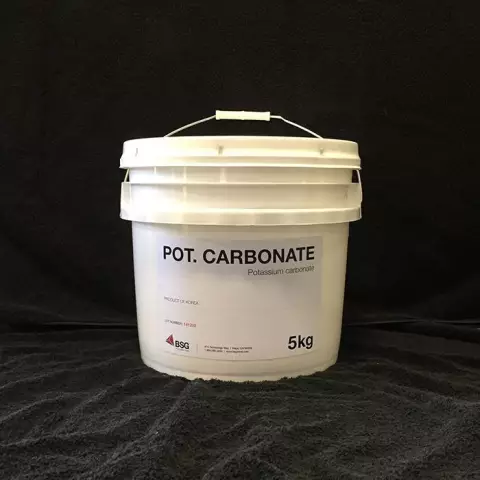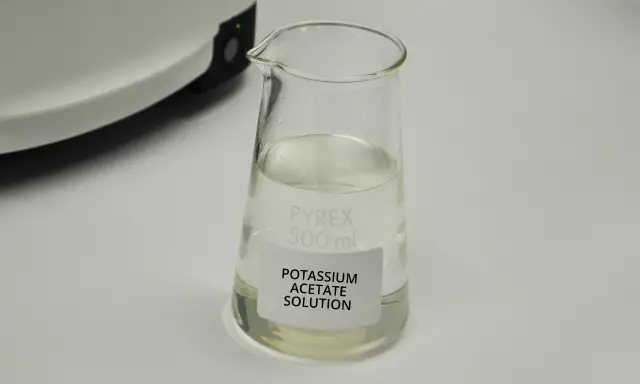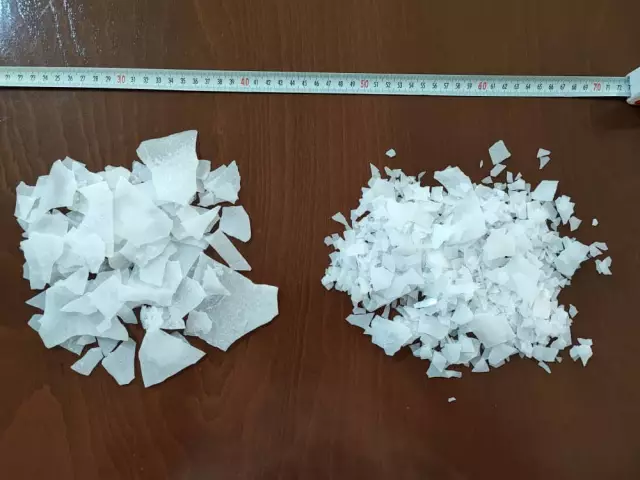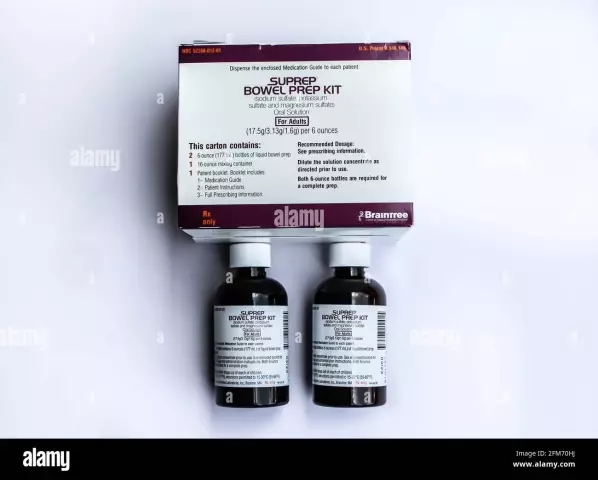- Author Rachel Wainwright [email protected].
- Public 2023-12-15 07:39.
- Last modified 2025-11-02 20:14.
Potassium and magnesium asparaginate
Latin name: Potassium-magnesium asparaginate
ATX code: A12CX
Active ingredient: potassium and magnesium aspartate (Potassium aspartate and Magnesium aspartate)
Producer: LLC "IST-PHARM" (Russia); LLC "Pharmasintez-Tyumen" (Russia)
Description and photo update: 2019-12-07

Potassium and magnesium asparaginate is a drug that compensates for the lack of potassium and magnesium in the body.
Release form and composition
Potassium and magnesium asparaginate is available in the following dosage forms:
- solution for infusion: clear, slightly colored or colorless liquid (250 ml or 500 ml in polyethylene bottles, 1 bottle in a cardboard box or a hermetically sealed polymer bag; for hospitals - in cardboard boxes from 1 to 96 bottles without bags or in hermetically sealed sealed bags);
- concentrate for the preparation of solution for infusion: transparent, slightly brownish-yellow or colorless (5 ml or 10 ml each in polyethylene ampoules with markings, in a cardboard box of 10 ampoules connected in cassettes).
Each pack also contains instructions for the use of Potassium and Magnesium Asparaginate.
Composition for 1 ml of solution for infusion:
- active ingredients: anhydrous magnesium L-asparaginate - 7.86 mg and anhydrous potassium L-aspartate - 10.02 mg (obtained from 15 mg of aspartic acid, 1.1 mg of magnesium oxide and 3.29 mg of potassium hydroxide);
- auxiliary components: sorbitol - 20 mg, water for injection - until a volume of 1 ml is obtained.
The theoretical osmolarity of the infusion solution is 260 to 340 mOsm / L.
Composition for 1 ml of concentrate:
- active ingredients: anhydrous potassium L-aspartate - 43.3 mg and anhydrous magnesium L-aspartate - 35.8 mg (obtained from 62.8 mg of aspartic acid, 5 mg of heavy magnesium oxide and 14.2 mg of potassium hydroxide);
- auxiliary components: sorbitol - 20 mg, water for injection - until a volume of 1 ml is obtained.
The theoretical osmolarity of the concentrate is 988 mOsm / l, the actual is 680-800 mOsm / l; electrolyte concentration: magnesium ions - 124 mMol / L, potassium ions - 253 mMol / L.
Pharmacological properties
Pharmacodynamics
Potassium and Magnesium Asparaginate is a source of magnesium and potassium ions. The drug eliminates the lack of magnesium and potassium in the body, improves metabolism in the heart muscle, normalizes the balance of electrolytes. The mechanism of action is due to the participation of asparaginate in the transfer of potassium and magnesium ions into the intracellular space.
Potassium activates the synthesis of glycogen, acetylcholine, proteins and ATP (adenosine triphosphoric acid).
Magnesium stimulates sodium-potassium adenosine triphosphatase, an enzyme of the cell membrane that selectively pumps out sodium ions from the cell and accumulates potassium ions in it. In addition, magnesium reduces the sodium content and prevents its exchange for calcium in the smooth muscle fibers of blood vessels, thereby reducing their resistance.
Both potassium and magnesium support the polarization of cell membranes.
In general, potassium and magnesium asparaginate regulates synaptic transmission, conduction of nerve impulses, myocardial function and muscle contraction. Thanks to magnesium ions, it takes part in the processes of energy consumption and supply, normalizes neuromuscular conductivity and permeability of cell membranes, as well as phosphate synthesis and oxygen absorption.
Pharmacokinetics
Ions of magnesium and potassium are quickly absorbed and distributed to tissues. Approximately 30% of the introduced magnesium enters into a bond with plasma proteins, resulting in the formation of complex compounds. The main amount of magnesium and potassium ions is excreted in the urine, a small part - with tears, sweat, feces, etc.
In patients with renal insufficiency, the excretion of magnesium and potassium ions may be slowed down.
Indications for use
Potassium and magnesium asparaginate is used to compensate for the lack of magnesium and potassium in the body (as an adjuvant) as part of a combination treatment for the following diseases and conditions:
- chronic heart failure;
- various manifestations of coronary heart disease (including myocardial infarction);
- cardiac arrhythmias (including arrhythmias due to intoxication with cardiac glycosides).
Contraindications
Absolute:
- severe renal dysfunction;
- arterial hypotension;
- atrioventricular (AV) blockade of the II and III degree;
- acute metabolic acidosis;
- destruction of red blood cells (hemolysis);
- a sharp slowdown in the formation of urine (oliguria);
- lack of urine flow into the bladder (anuria);
- severe myasthenia gravis;
- dehydration;
- shock;
- hypermagnesemia and / or hyperkalemia;
- Addison's disease;
- insufficient function of the adrenal cortex;
- children and adolescents up to 18 years old;
- hypersensitivity to the main or auxiliary components of the drug.
Relative (Potassium and magnesium asparaginate is used with caution):
- severe liver dysfunction;
- decrease in renal function if it is impossible to regularly monitor serum magnesium levels (due to the danger of accumulation and an increase in magnesium concentration to toxic values);
- AV block I degree;
- metabolic acidosis;
- urolithiasis (uric acid) diathesis;
- low blood phosphate levels;
- increased risk of edema formation;
- the period of pregnancy and lactation.
Potassium and magnesium asparaginate, instructions for use: method and dosage
Solution for infusion
Potassium and magnesium asparaginate infusion solution is administered intravenously.
The dose is selected individually and depends on the indications. Unless otherwise prescribed, it is recommended to inject a solution of 500 ml 1-2 times a day at a maximum rate of no more than 5 ml / kg of body weight per hour.
Before cardiac surgery, potassium and magnesium asparaginate is administered in a dose of 500 ml per day once for one week before the planned intervention, and then for another week after the surgery (at the same dose).
Concentrate for solution for infusion
Potassium and magnesium asparaginate in the form of a concentrate is administered intravenously (in diluted form) in individual doses, which depend on the indications.
To prepare the infusion solution, the concentrate is diluted in 100-200 ml of 0.9% sodium chloride solution or 5% glucose (dextrose) solution. For one dilution, the contents of 1-2 ampoules of 10 ml or 2-4 ampoules of 5 ml are required. The rate of administration is 20-25 drops per minute.
Treatment of potassium and magnesium with aspartate is carried out until the pathological symptoms decrease or disappear (sometimes within several days).
Side effects
If the drug is administered according to the rules, in compliance with the recommended rate, side effects are rare.
With the rapid intravenous administration of a solution of potassium and magnesium asparaginate, symptoms of hypermagnesemia and hyperkalemia (vomiting, nausea and muscle weakness), the occurrence of reactions from the cardiovascular system (arrhythmia, decreased heart rate, AV blockade, excessive decrease in blood pressure, phlebitis), a paradoxical increase in the number of extrasystoles), as well as side effects from the nervous system (paresis, decreased or absent one or more reflexes, paresthesia, respiratory depression, coma, convulsions).
Overdose
An overdose of potassium and magnesium asparaginate is possible in cases where the drug is administered in ultra-high doses, significantly exceeding the recommended ones. The patient may develop hyperkalemia and hypermagnesemia, which are manifested by the following symptoms:
- signs of hyperkalemia: cardiac arrhythmias, ventricular fibrillation, decreased heart rate, vascular collapse, excessive drop in blood pressure, cardiac arrest during relaxation of the ventricles and atria, impaired sensitivity, paresthesia of the legs, confusion, general weakness;
- signs of hypermagnesemia: deterioration of AV conduction and spread of excitation in the ventricles, vomiting, nausea, constipation, excessive decrease in blood pressure, bladder atony, extinction of deep tendon reflexes, lethargy, respiratory depression.
In case of overdose, potassium and magnesium asparaginate should be canceled immediately and 20% sodium chloride solution or 10% calcium gluconate solution should be administered. The resulting cardiovascular disorders are corrected using symptomatic therapy. If necessary, perform peritoneal dialysis or hemodialysis.
special instructions
For the introduction, you can use only absolutely transparent solutions in undamaged ampoules or vials. The drug should be used immediately after opening the ampoule or vial.
Intravenous infusion should be given slowly.
If, when mixing potassium and magnesium asparaginate with other infusion or injection solutions, a precipitate forms or opalescence appears, these mixtures are not recommended to be used.
Influence on the ability to drive vehicles and complex mechanisms
Special studies of the effect of potassium and magnesium asparaginate on the ability to drive motor vehicles and other vehicles, as well as to engage in other potentially hazardous work that requires high concentration of attention and quick reactions, have not been carried out.
Application during pregnancy and lactation
There are no data on the safety of the use of potassium and magnesium asparaginate in pregnant women, therefore, during this period, the drug is prescribed only for health reasons.
During breastfeeding, the infusion solution is administered with caution, since there is no data on the penetration of the drug components into breast milk.
Pediatric use
Potassium and magnesium asparaginate are not prescribed for patients under 18 years of age, since there is no data on the effectiveness and safety of its use in pediatrics.
With impaired renal function
Potassium and magnesium asparaginate is contraindicated in persons with severe renal impairment. If renal function is slightly reduced and there is no possibility of regular monitoring of serum magnesium concentration, infusion is carried out with caution.
For violations of liver function
Potassium and magnesium asparaginate is used with caution in severe liver dysfunction.
Drug interactions
The risk of hypermagnesemia or hyperkalemia increases if the drug is used together with beta-blockers, non-steroidal anti-inflammatory drugs, potassium-sparing diuretics and ACE inhibitors (angiotensin converting enzyme).
With an increase in the concentration of potassium ions in the extracellular space, the effectiveness of cardiac glycosides decreases, which leads to an increase in the arrhythmogenic effect.
Magnesium and potassium preparations eliminate hypomagnesemia and the lack of potassium ions, which are caused by glucocorticosteroid drugs.
Potassium ions reduce the incidence of unwanted side reactions of cardiac glycosides.
Avoid combined use with tetracycline, polymyxin B and aminoglycosides (streptomycin, neomycin, etc.).
Potassium and magnesium asparaginate should not be combined with anesthetics, as there is a risk of neuromuscular blockade, including respiratory depression. Neuromuscular blockade caused by depolarizing muscle relaxants (suxamethonium chloride / iodide / bromide, decametonium bromide, atracuria besylate) can be enhanced with the use of magnesium preparations.
Calcium-containing agents reduce the effectiveness of magnesium, and drugs for general anesthesia increase the inhibitory effect of magnesium on the nervous system.
Analogs
The analogues of potassium and magnesium asparaginate are Asparkam, Asparkam Avexim, Asparkam-UBF, Asparkam-L, Asparkam-Farmak, Panangin, Panaspar, Panangin Forte, Potassium and magnesium asparaginate Berlin-Hemi.
Terms and conditions of storage
Store in a dark place at a temperature of + 2 … + 25 ° C. The drug must not be frozen. Keep out of the reach of children.
Shelf life: solution for infusion - 3 years; concentrate for preparation of solution for infusion - 2 years.
Terms of dispensing from pharmacies
Dispensed by prescription.
Reviews about potassium and magnesium aspartate
There are few reviews of potassium and magnesium aspartate. Most often, the drug is used for diseases of the cardiovascular system, since potassium and magnesium are essential elements for the normal functioning of the heart and neuromuscular transmission. Patients report a decrease in high blood pressure and a decrease in heart rate. Sometimes side effects occur during treatment, such as nausea and arrhythmias.
Price for Potassium and Magnesium Asparaginate in pharmacies
Limit prices for potassium and magnesium asparaginate in pharmacies have been set:
- solution for infusion 250 ml: 1 bottle per package - 60 rubles; 24 bottles per package - 1452 rubles;
- solution for infusion 500 ml: 1 bottle per package - 112 rubles; 24 bottles per package - 2625 rubles;
- concentrate for the preparation of a solution for infusion, 10 ampoules per package: 5 ml ampoules - 90 rubles; ampoules 10 ml - 180 rubles.

Maria Kulkes Medical journalist About the author
Education: First Moscow State Medical University named after I. M. Sechenov, specialty "General Medicine".
Information about the drug is generalized, provided for informational purposes only and does not replace the official instructions. Self-medication is hazardous to health!






